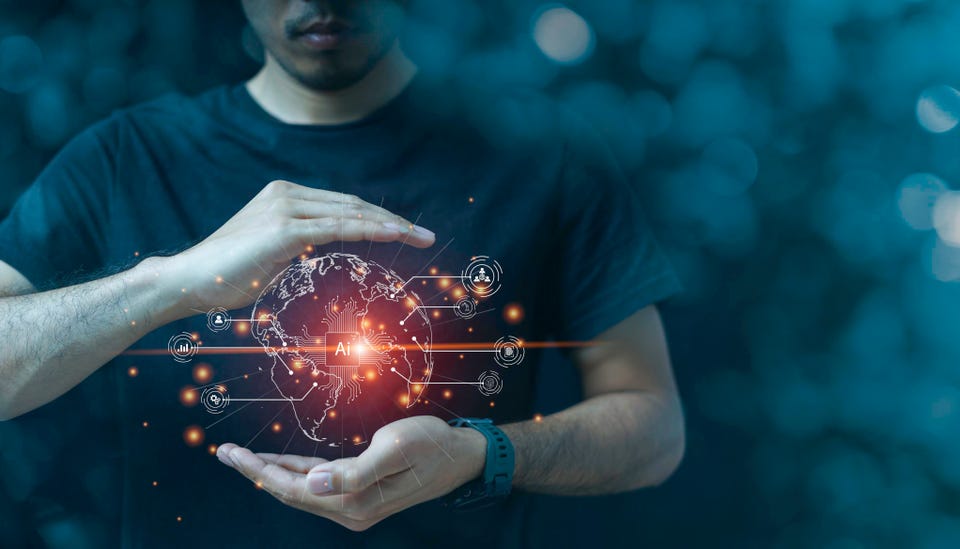How Artificial Intelligence Could Reinvent The Communications Industry


With the continuous improvement of artificial intelligence (AI), expert research shows that AI has the power to double yearly economic growth rates by 2035 and completely revolutionize how humans work, create and communicate.
However, the advent of AI engines like DALL·E 2, Midjourney and Point-E have left many creators worried that AI will leave humans with no creative outlet. The good news is that this is not the case.
AI has advanced enough in its communication skills to even fill the role of a close companion or dynamic, interactive acquaintance. Programs like Journey AI and Replika have intriguing tag lines like “AI devoted to you” and “the AI companion who cares.” These types of companions are available 24/7 and can be customized to fit whatever kind of companion the user is looking for. This can include everything from a sympathetic friend to a realistic replica of a favorite book character, looks and personality included.
In fact, AI is poised to reinvent the entire communications industry and pave the way for better, more accessible human expression by eliminating monotonous tasks and expanding creative potential.
Let AI draft that text so you don’t have to.
Copywriting can be tedious and time-consuming, and even if you outsource it, you still have to worry about finding reliable writers, managing payroll and other monotonous tasks.
With tools like OpenAI’s GPT-3 and Jasper AI, the communications industry can spend less time crafting text and more time focused on connecting with clients, researching features or working on new creative endeavors. In addition, utilizing these AI tools as writing assistants can help journalists, authors and content creators come up with better ideas, formulate text with fewer spelling or grammar errors, and even make sure large bodies of work maintain a consistent tone and style.
It can also help with search engine optimization (SEO) by creating quality text that, with the help of a human editor, sounds human and reads well, broadening visibility and strengthening brand authority with minimal resource investment.
However, it’s important to mention the potential drawbacks of this. For instance, search engines like Google are cracking down on certain types of AI-generated text to help prevent plagiarism. This can mean SEO penalties for companies, so it’s something to stay aware of.
It’s also worth noting that these texts are not immune to including bias or misinformation. This is why AI-generated content must still be carefully checked by experienced humans; otherwise, it could cause problems for the person posting. The same thing can happen with images, as noted by examinations of DALL·E 2.
AI can be the marketer’s best friend.
The recent concerns about AI-generated articles and texts have shone a spotlight on an issue many creators have worried about for years: the fear that AI will learn to replicate any writing style, taking away an entire industry of jobs and impeding educators’ abilities to foster critical thinking skills in students.
While these are valid concerns, it is equally important to see how generative AI can expand human “creative horizons,” too.
For example, AI isn’t limited by human imagination, so it can potentially generate TV show pilots, text prompts and nonstandard answers to questions that human brains might not come up with. Some people call this “AI remixing” since it’s taking a huge amount of human information and creating new iterations of it. This makes it a nearly endless source of creative inspiration for new projects. In fact, Netflix is already well known for using sophisticated AI algorithms when deciding whether or not to develop new content.
In addition, these same unique and predictive powers of AI can be leveraged to help industry professionals get a jump on what may be trending next, giving companies a competitive edge by allowing for more agile marketing. This is a strategy used by TikTok, and the hyper-personalization allowed by AI is a vital part of their successful strategy to grow their user base. They rely on a user-led “infinite loop” powered by AI to build a uniquely personalized profile for each person.
AI is here to stay, and it can take human creativity to new heights.
Is AI able to be evocative and creative in the same way that humans are? No, and it likely will not ever possess the same kind of creativity as humans. Creators are the true genius behind what generative AI can do, and that’s something to be excited about and proud of.
Currently, AI is assisting us in creating more personalized content, driving ad revenues and SEO rankings, helping us learn how to communicate better via chatbots, and offering rudimentary yet unprecedented machine-generated entertainment opportunities (think Hatsune Miku or hologram performances of Tupac).
In the future, AI will likely be responsible for creating much of the content we consume. However, its function will still be that of a unique, useful tool rather than a replacement for human creativity. It’s true that there are ethical issues to be discussed and overcome, but there is no denying that AI can broaden the scope of what humans believe is possible and lead us to new creative heights that we cannot even imagine yet.
